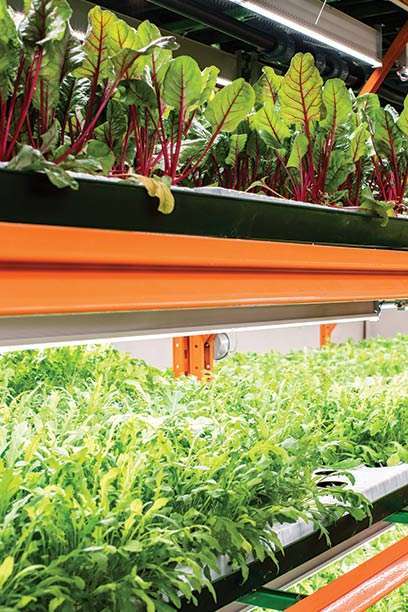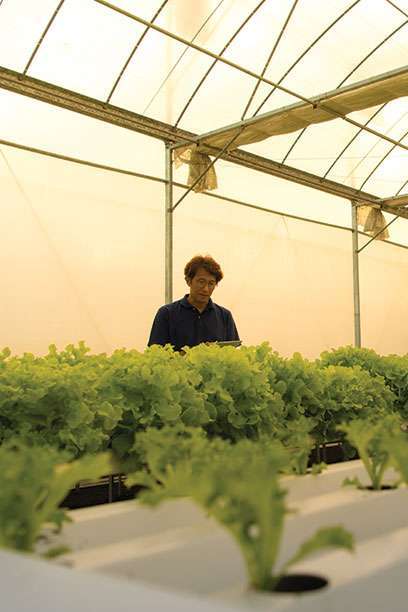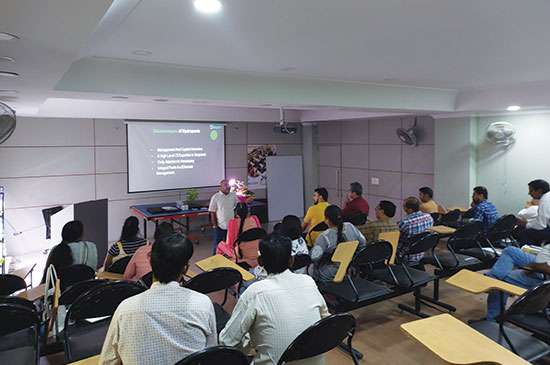Move Your Training Program From an Expense to an 'Investment'
With our customer -specific training we taught whatever, whenever and however you want from our experts for your employees. This can be delivered in a variety of ways: at an SmartBrains facility, In-house, on site as an incenter Training or Virtual Live Classroom training.


Inhydro’s Corporate training, Also known as Corporate Education or more recently Workplace Learning, is a system of activities designed to educate employees or Hydroponics professionals.. While it helps employers, it is also beneficial for employees as it helps them obtain and hone knowledge and skills to progress professionally and personally.
Creating people capability, developing learning strategy and sustaining a learning culture is now a strategic priority for every professional. The Future Learning and Development Leader Programme is aimed at helping Learning and Development professionals build a roadmap for the future by developing their core skills and power skills.
Key-Highlights
Goal Oriented
When structuring training programs, ensure they are goal oriented and the Key Performance Indicators chosen paint a wholistic picture - time, cost, effectiveness, quality and quantity of the program.
Post Training
Organizations spend thousands of dollars each year on employee training with little knowledge of whether it's "working". Incorporating post training follow ups, such as short lessons or activities to review new concepts learnt or face to face feedback sessions, can help ensure concepts are understood and actively practiced.
Relevancy And Need
The experience and information we offer your employees must be relevant, timely and applicable to their daily job activities. It should help them expand their knowledge, skills and should be easy to digest so they learn quickly and can implement what they learn.
Client & Project Input
Client involvement is important to increase employee engagement in learning. A survey conducted by LinkedIn, noted that 56% of employees would spend more time on their training if their project directed, or recommended, them to a specific program that directly they believe will improve their skills.
Creativity
Workplace learning is evolving to a place where adding fun, bite-sized and relevant activities to training is becoming increasingly popular to increase employee engagement. Moving away from traditional trainer style learning, or online learning experience similar to flicking through a powerpoint presentation, will allow you to explore more creative possibilities.
Alignment
Anything you train your employees on must be aligned with your organizational goals. Don’t ask your employees what training they want or need instead, focus on what are the business outcomes and then identify the capabilities needed to achieve those outcomes. Then you can decide collectively what specific skill sets are needed by your employee base and the the types of learning experiences you need to create.

A Quick Input of What Our Corporate Training Programs Enable
- Better community members and happier individuals
- Upskill or maintain knowledge of current job related tasks
- Develop personal skills and abilities for soft skill topics to plan for personal growth
- Providing employees with career growth opportunities aligned with company objectives, goals and strategies
- Enhance or obtain education, abilities and skills for duties unrelated to current job to achieve self-set goals and career objectives
Learn all about hydroponics systems, designs, and applications. This course provides an in-depth knowledge of all aspects of hydroponics; suitable for progressive growers, manufacturers, retailers, suppliers, entrepreneurs, and consultants who want to explore the Hydroponics system. It’s an inclusive course which provides Interactive lectures and hands-on trainings. Be a hydroponic expert and join the program.
Our Best-in-Class Learning Services

Agenda
- Introduction to Hydroponics
- History of Hydroponics
- Advantages/Disadvantages of Hydroponics
- Global industry
- Comparison to growing in soil
- Plant structure
- How Plants Grow
- Photosynthesis
- Light, Water and nutrients Requirements
- CO2, O2, Temperature, Humidity and other requirements
- The role of pH in plant growth
- The role of EC in Plant Growth
- How and where to start Hydroponics
- Planting of seeds & germination characteristics
- What can be grown in Hydroponics
- Growing Media
- The Perfect Grow Medium
- Type of Media
- Coco peat. Vermiculite, Perlite, rook wool, Leca etc.
- Advantages & Disadvantages of various grow mediums
- How to choose perfect medium for various system
- Food Safe Material Hydroponics
- Selection & Sizing of NFT Channels
- Selection & Sizing of reservoir tanks
- Selection & Sizing of Pumps & Motors for various Systems
- Selections of Various Tools used in Hydroponics
- Selection of Air pumps for Aeration
- Selection of Grow Lights
- Plant structure
- How Plants Grow
- Photosynthesis
- Light requirements
- Natural Lights
- Artificial Lighting
- Plant Propagation Techniques
- Temperatures required for
- Seed Germination of Vegetables and Herbs
- Seedling Development
- Types of Cuttings
- Stock Plants
- Hormone Treatment of Cuttings
- Other Chemical Treatments
- Other Treatments to Improve Cutting Success
- Using Artificial Light in Plant Propagation
- Growing Media, Propagating Media, Components
- Mixes/Substrates for Striking Cuttings/Starting Bed
- Using Fertilizers in Propagation Mixes
- Nutrition Management
- Factors Affecting Fertilizer Application
- Efficiencies in Cutting Production
- Example of Estimating Cost of Cutting Productions
- Tissue Culture
- Tissue Culture Procedures
Environmental Conditions
- Fungi
- Common Fungal Problems
- Pest & Disease Control Measures: Integrated pest
management (IPM), Nutrient solution management - Common Pests & Diseases
Pests: Aphids, Thrips, Whitefly, Caterpillars, Leaf Miners,
Mites, Mealy Bugs, Scale Insects, Leafhoppers, Slugs
and Snails, Flies, Other pests - Common Diseases: Botrytis – Grey mould, Mildew
diseases, Rusts, Rots, Bacterial diseases, Viruses - Problem solving and identification of illness
- leaf hoppers; thrip; virus; bacteria; caterpillars; harlequin
bugs and more - Plant Viruses – Their Detection and Diagnosis
- Virus Control
- Environmental Problems
- Common Environmental Problems
- Significance of understanding chemistry for hydroponicsUnderstanding Basic Chemistry
Water Quality: Hard water, Water pH, Water EC, Sodium
Chloride, Turbidity, Smell and colour, Iron content,
dissolved oxygen etc - Obtaining a Water Analysis for Hydroponics
- Water Treatments
- The important Plant Nutrients
- Plant Nutrition – The Nutrient Elements
- Mechanisms of Nutrient Uptake
- Hydroponic Nutrient
- Preparing Nutrient Solutions
- Fertilizer Salts for Formulations
- Nutrient Formulations
- Nutrient Formulation Stock Solutions
Nutrient Formulation: Formulas for different systems, - Stage of growth – grow vs bloom formulas
Making up Hydroponic Stock Solutions Fertilizer Salts - Mixing Nutrients
- Choosing the Right Fertilizers
- Tomatoes: Growing Tomatoes, Capsicums, Cucumber,
- Flower Production: Gerbera, Gladiolus, Roses, Hydroponic
Lily, Dahlia, Orchids
- Growing Plants in a Greenhouse
- The Greenhouse System
- Types of Greenhouses
- Commonly used Greenhouse Designs
- Shape of Structures to Maximise Light Transmission
- Problems with Greenhouses
- Horticultural Management in a Greenhouse
- Greenhouse Irrigation Methods
- Culture and Management of some Greenhouse Crops
- Optimum Growth Requirement for Certain Plants
- light factors in greenhouse
- Greenhouse Benches and Beds: Shelving or Staging, Ground Beds, Raised Beds, Pot Crops, Flooring, Guttering, Doors
- Hydroponic Salad Greens: Lettuce, Celery, Spinach, Kale,
Pokchoy, Swiss chard - Hydroponic Herb Production: Basil, Mint, Sage, Thyme,
parsley, Chives, Rosemary Fruits & Vegetables - Strawberry, Broccoli, cauliflower, cabbage, Asparagus,
Beans, Beetroot, Carrots, Okra
- Physical Layout of the Workplace
- Layout of Shop, Fruit Set Management
- Controlling Plant Growth
- What is Hydroponic Trial?, Running a Crop Trial
- Trellising, pruning, pollination, transplanting
- Research Methodology
- The Importance of Harvest and Post-Harvest Management
- Understanding Harvested Crop Physiology
- Harvesting and Grading Vegetables
- What is Considered Within a Grading Standard
- Harvesting Cut Flowers, Managing a Market Garden
- Deciding What To Grow, Crop Scheduling
- The Importance of Harvest and Post-Harvest Management
- Understanding Harvested Crop Physiology: Ripening of fruit,
Respiration, How and when to harvest, How to prepare salad
mixes from harvested hydroponic produce - Harvesting and Grading Vegetables
- What is Considered Within a Grading Standard?
- Harvesting Cut Flowers: Stage of growth, Shelf life, Postharvest treatments, grading standards for cut flowers,
Conditioning cut flowers for market, Packaging - Marketing: Send to markets, Wholesalers, Supermarkets,
Local retailers, Export, Contract
- Marketing
- Publicity
- Public Relations
- Press Releases
- Selling
- Types of Customers
- Keys to Improving Sales
- Key Strategies For Selling
- Marketing Your Produce
- Market Research
- Areas of Market Research
- Sources of Data
- What Do You Need To Research?
- Marketing Tips
- Environmental Control
- Environmental Factors that Influence Plant Growth
- Measurement of Environmental Factors
- Temperature Control
- Cooling Systems
Why InHydro ?

What People Say

I am Harshit. This workshop refreshed me. It was meticulously planned. Each session had a good insight. Thanks to Mr. Awneesh Kumar and his team to have put up a good show. Keep spreading the knowledge sir.
Mr. Harshit Singhal

I am Vidushi Sharma I am also in vertical garden since 2010 found session very knowledgeable, Participants very Interactive was value for money and time .
Mrs. Vidushi Sharma

Hi, My name is Prescilla. An organic entrepreneur and an enthusiastic urban gardener. InHydro workshop helped me with more insights on the technology behind Hydroponics. Very interactive session. I would really appreciate for another workshop either online or offline it’s fine as I had to cut short the workshop . Thank you and keep spreading knowledge.
Mrs. Prescilla

The work shop was great! I enjoyed the lecture and loved the tour. Though I feel that the touring experience can be done better with more guides and in smaller groups. It was quite a learning experience. Before coming here I only had very basic knowledge about the subject and the experience there helped me gain much more. I also loved your business proposals. The staff was very nice and helpful. Thank you for this experience. Regards Abdullah Tarin
Mr. Abdullah Tarin

I have attended the workshop on Hydroponics,. To be frank, it was one of the rarest workshops i have taken and learnt a lot about a very unique technique of farming. The workshop was very much proper with proper content. I highly recommend to everyone to gain knowledge about vertical farming as a hobby or whoever wishes to make his/her career in a very unique and highly demanding aggrotech domain. Regards : Sumit
Mr. Sumit Singh

I came to know about this training via Facebook and so amazed with the delivery and state-of-art facilities at InHydro Noida centre. Thank you team InHydro and Mr. Awneesh for your valuable time and training materials.
Mr. Sunil Joshi

I am a professional grower, this workshop really met mine expectation. I will appreciate the effort put by the mentor for Business planning and Crop-selection. Kudos to this team.
Mrs. Irene Gupta

We attended this session at Noida Sector 59 under the guidance of Mr. Awneesh. It was a very interesting & informative session. I do box farming on my rooftop. I would like to try indoor hydroponics.
Mr. Piyush Rai & Mrs. Sweta Rai

The whole new concept of farming just got un-covered during this detailed session and Hydroponics Farm visit at Inhydro center. Lunch and hospitality provided by team is too good.
Mr. Salim Haider

It was a nice session and I learned a lot about hydroponic technique. Thanks for a nice and excellent workshop. The true meaning of Sustainable Farming just got realized with the effective design and production mechanism provided by Inhydro. During their training Clean, Green, and Healthy way of producing daily need veggies can be achieved with these hands-on workshops.
